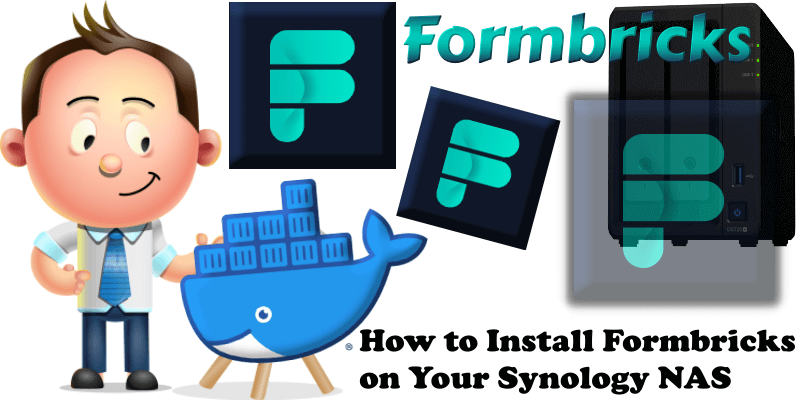
Formbricks is a solution for in-product micro-surveys that promises to supercharge your product experience. Formbricks provides a free and open source surveying platform. Gather feedback at every point in the user journey with beautiful in-app, website, link and email surveys. In this step by step guide I will show you how to install Formbricks on your Synology NAS using Docker & Portainer.
This guide works perfectly with the latest Formbricks v4.4.3 release.
STEP 1
Please Support My work by Making a Donation.
STEP 2
Install Portainer using my step by step guide. If you already have Portainer installed on your Synology NAS, skip this STEP. Attention: Make sure you have installed the latest Portainer version.
STEP 3
Make sure you have a synology.me Wildcard Certificate. Follow my guide to get a Wildcard Certificate. If you already have a synology.me Wildcard certificate, skip this STEP.
STEP 4
Go to Control Panel / Login Portal / Advanced Tab / click Reverse Proxy. Follow the instructions in the image below.
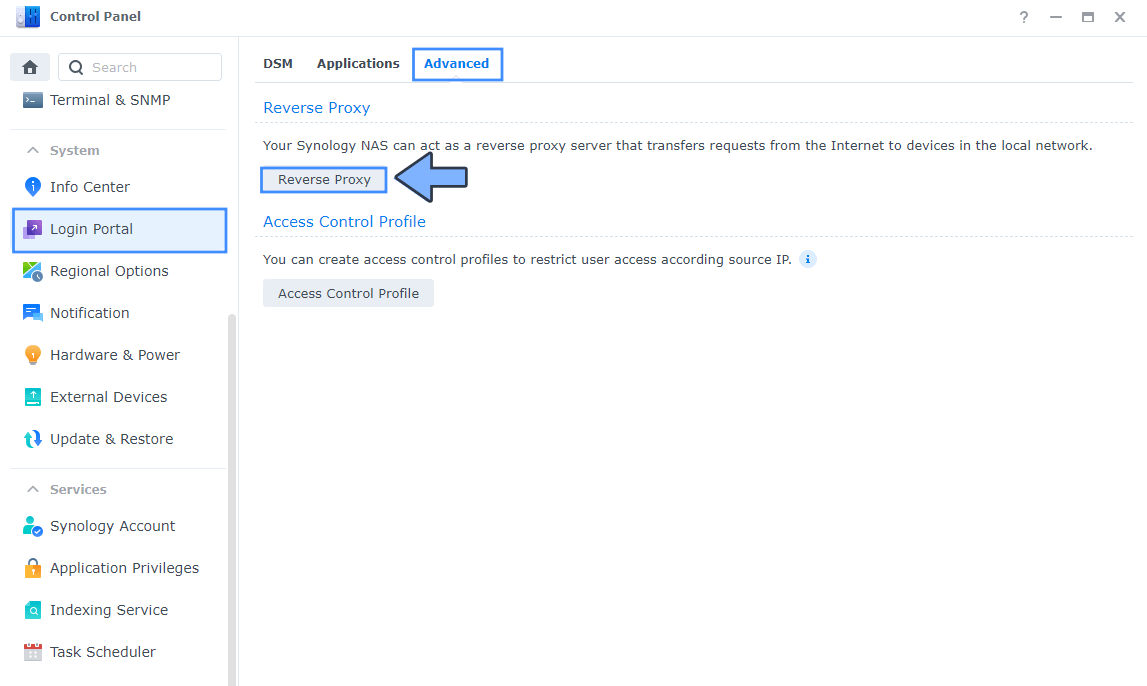
STEP 5
Now click the “Create” button. Follow the instructions in the image below.
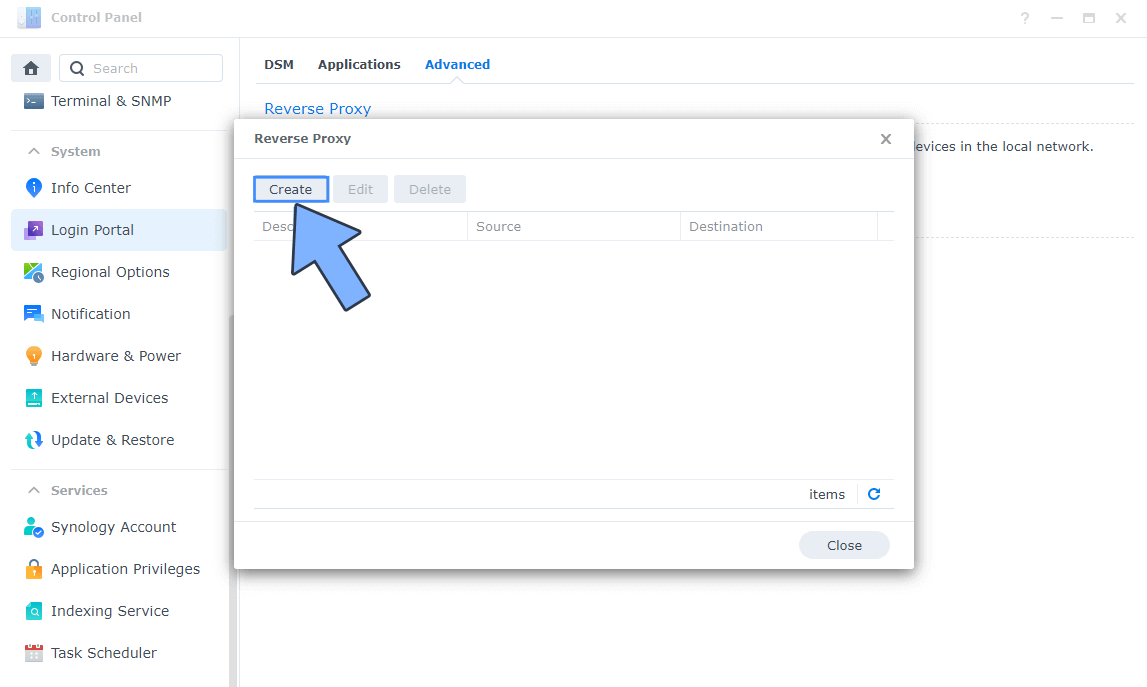
STEP 6
After you click the Create button, the window below will open. Follow the instructions in the image below.
On the General area, set the Reverse Proxy Name description: type in Formbricks. After that, add the following instructions:
Source:
Protocol: HTTPS
Hostname: formbricks.yourname.synology.me
Port: 443
Check Enable HSTS
Destination:
Protocol: HTTP
Hostname: localhost
Port: 3774
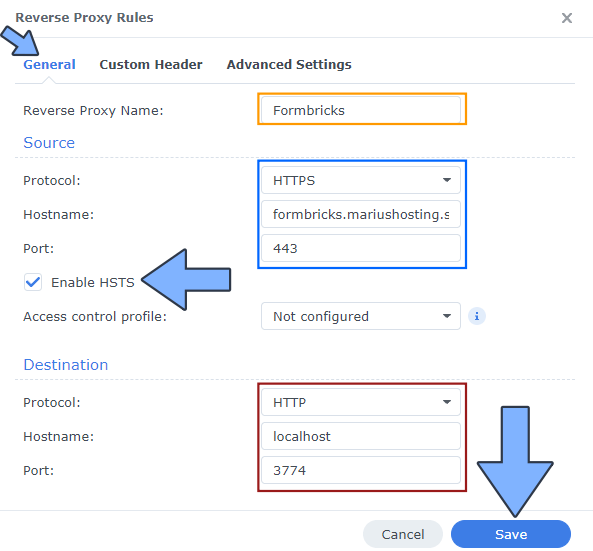
STEP 7
On the Reverse Proxy Rules, click the Custom Header tab. Click Create and then, from the drop-down menu, click WebSocket. After you click on WebSocket, two Header Names and two Values will be automatically added. Click Save. Follow the instructions in the image below.

STEP 8
Go to Control Panel / Network / Connectivity tab/ Check Enable HTTP/2 then click Apply. Follow the instructions in the image below.
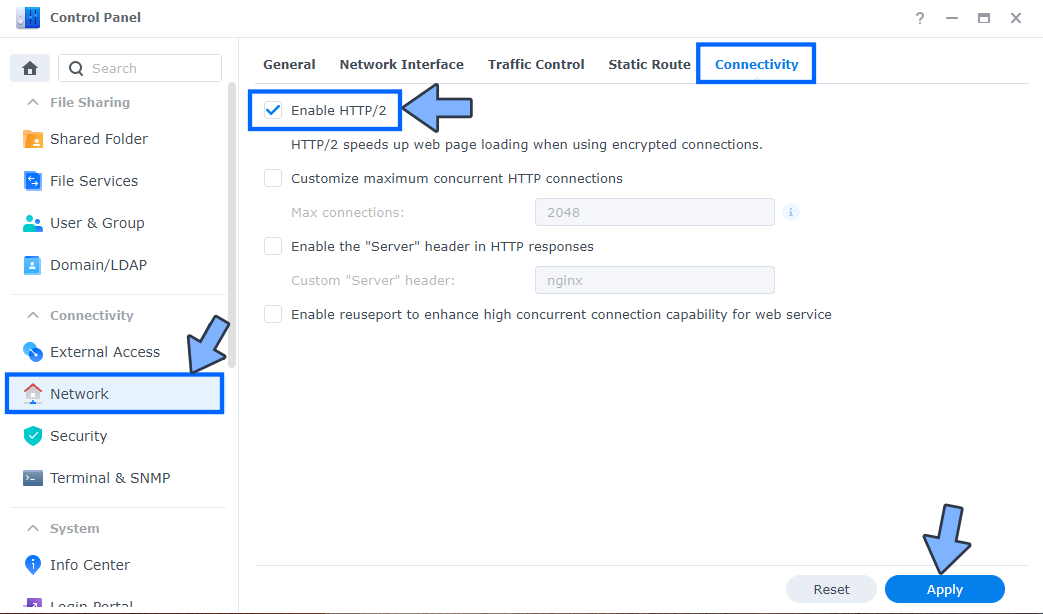
STEP 9
Go to Control Panel / Security / Advanced tab/ Check Enable HTTP Compression then click Apply. Follow the instructions in the image below.
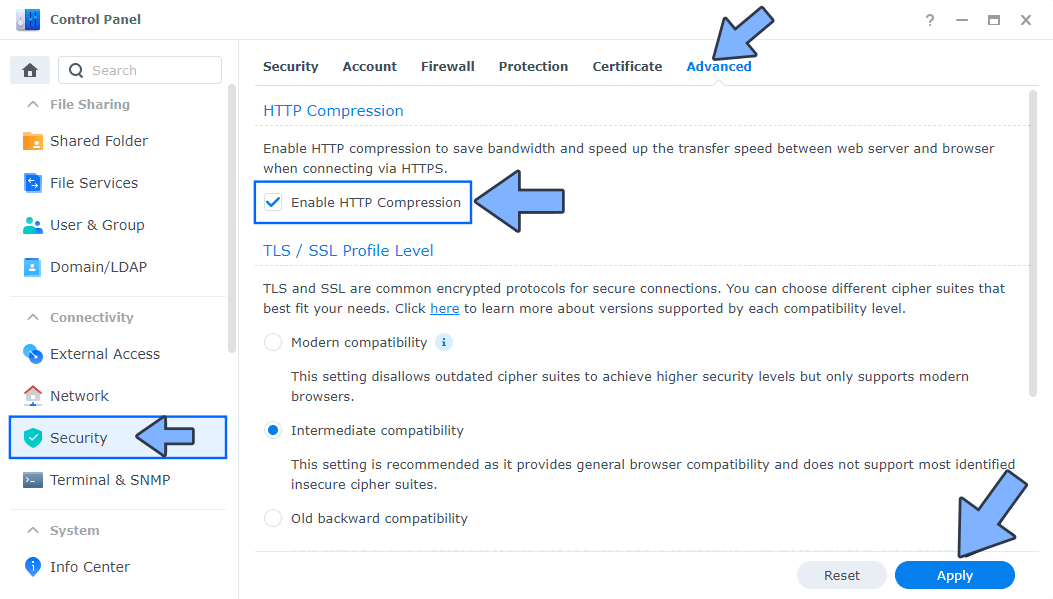
STEP 10
Go to File Station and open the docker folder. Inside the docker folder, create one new folder and name it formbricks. Follow the instructions in the image below.
Note: Be careful to enter only lowercase, not uppercase letters.
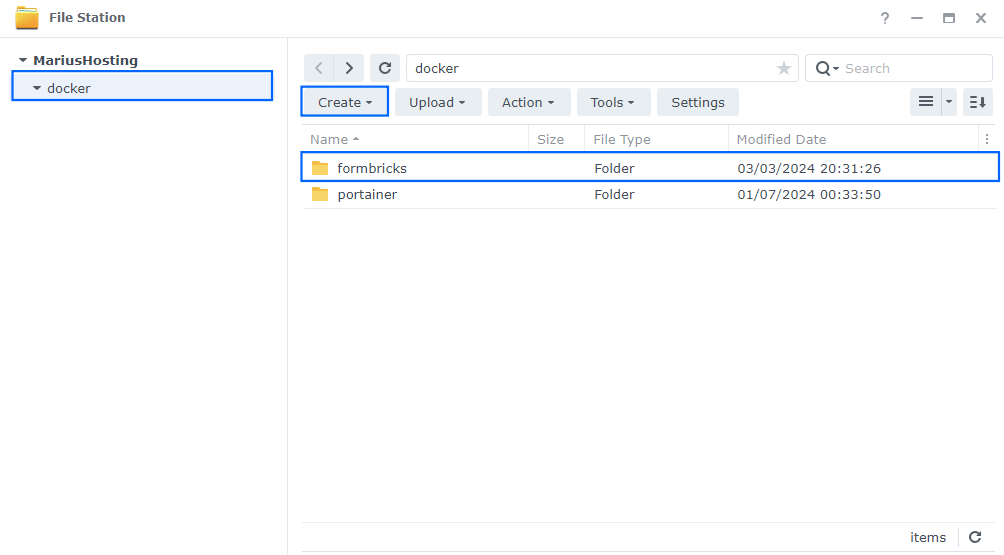
STEP 11
Now create five new folders inside the formbricks folder that you have previously created at STEP 10 and name them db, minio, redis, saml, uploads. Follow the instructions in the image below.
Note: Be careful to enter only lowercase, not uppercase letters.
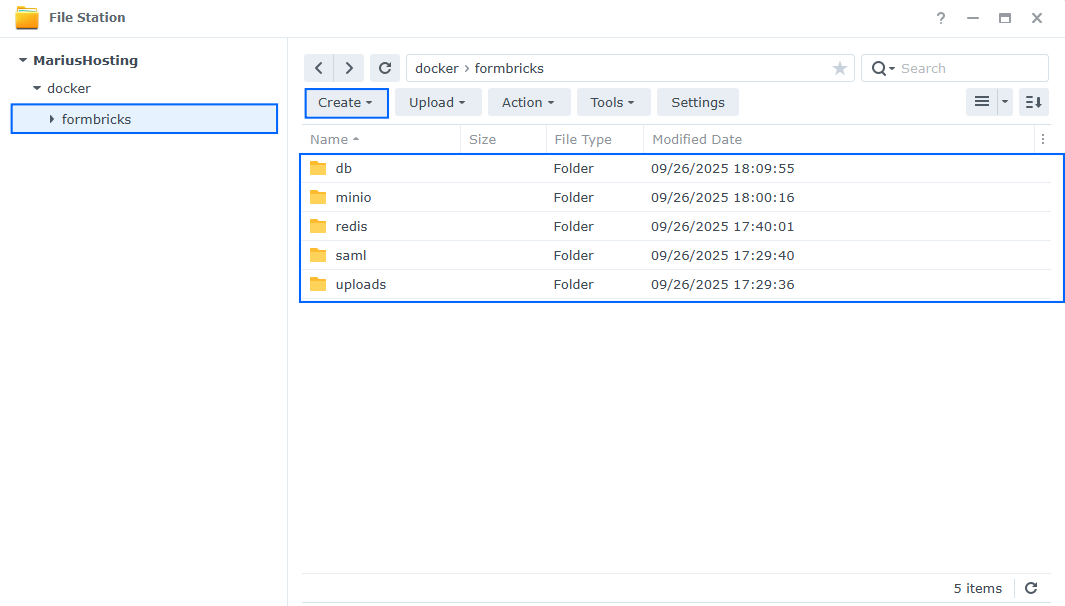
STEP 12
Follow my step by step guide on how to activate SMTP for your Gmail account. This step is mandatory. Note: If you don’t want to use the easiest way for SMTP with Google and you already have SMTP details from your own Mail Server, you can just skip this STEP and use your personalized email SMTP details instead.
STEP 13
Log into Portainer using your username and password. On the left sidebar in Portainer, click on Home then Live connect. Follow the instructions in the image below.

On the left sidebar in Portainer, click on Stacks then + Add stack. Follow the instructions in the image below.

STEP 14
In the Name field type in formbricks. Follow the instructions in the image below.
services:
redis:
image: redis
container_name: Formbricks-REDIS
security_opt:
- no-new-privileges:true
read_only: true
user: 1026:100
healthcheck:
test: ["CMD-SHELL", "redis-cli ping || exit 1"]
volumes:
- /volume1/docker/formbricks/redis:/data:rw
environment:
TZ: Europe/Bucharest
restart: on-failure:5
db:
image: pgvector/pgvector:pg17
container_name: Formbricks-DB
hostname: formbricks-db
security_opt:
- no-new-privileges:true
healthcheck:
test: ["CMD", "pg_isready", "-q", "-d", "formbricks", "-U", "formbricksuser"]
timeout: 45s
interval: 10s
retries: 10
volumes:
- /volume1/docker/formbricks/db:/var/lib/postgresql/data:rw
environment:
POSTGRES_DB: formbricks
POSTGRES_USER: formbricksuser
POSTGRES_PASSWORD: formbrickspass
restart: on-failure:5
minio:
image: minio/minio:latest
command: server /export --console-address ":9090"
container_name: Formbricks-MINIO
hostname: formbricks-minio
ports:
- 9220:9090
security_opt:
- no-new-privileges:true
user: 1026:100
healthcheck:
test: ["CMD", "mc", "ready", "local"]
interval: 5s
timeout: 5s
retries: 5
volumes:
- /volume1/docker/formbricks/minio:/export:rw
- /volume1/docker/formbricks/minio:/data:rw
environment:
MINIO_ROOT_USER: marius
MINIO_ROOT_PASSWORD: mariushosting
S3_REGION: us-east-1
S3_BUCKET_NAME: formbricks-uploads
S3_ENDPOINT_URL: https://formbricks.yourname.synology.me
S3_FORCE_PATH_STYLE: 1
restart: on-failure:5
formbricks:
image: ghcr.io/formbricks/formbricks:latest
restart: on-failure:5
container_name: Formbricks
healthcheck:
test: curl -f http://localhost:3000/ || exit 1
depends_on:
- db
- redis
- minio
ports:
- 3774:3000
volumes:
- /volume1/docker/formbricks/uploads:/home/nextjs/apps/web/uploads/:rw
- /volume1/docker/formbricks/saml:/home/nextjs/apps/web/saml-connection:rw
environment:
WEBAPP_URL: https://formbricks.yourname.synology.me
NEXTAUTH_URL: https://formbricks.yourname.synology.me
DATABASE_URL: "postgresql://formbricksuser:formbrickspass@formbricks-db:5432/formbricks?schema=public"
NEXTAUTH_SECRET: dOxZYTTZgXKMHkqLBIQVImayQXAVWdzGBPuFJKggzcgvgPJPXpWzqzKaUOIOGGIr
ENCRYPTION_KEY: bdfOSdpdGUlGMIzgTHKaYtOtVvmFifegVBopLTZbXkxMlePUWlyCrXcgqzWKUTvK
CRON_SECRET: MghEjrIXxtytcdowiTsyQeyOszuGsIejGwIAkYZxkSJfgTXTswkePxMyAmdaRlwUs
POSTGRES_PASSWORD: formbrickspass
REDIS_URL: redis://redis:6379
# ENTERPRISE_LICENSE_KEY:
EMAIL_VERIFICATION_DISABLED: 1 #Set to 0 to enable Email verification for new signups.
PASSWORD_RESET_DISABLED: 0 #Set to 1 to enable Password Reset.
SIGNUP_DISABLED: 0 #Set to 1 to disbale Signups.
INVITE_DISABLED: 0 #Set to 1 to disable Invites
MAIL_FROM: Your-own-gmail-address
SMTP_USER: Your-own-gmail-address
SMTP_PASSWORD: Your-own-app-password
SMTP_HOST: smtp.gmail.com
SMTP_PORT: 587
SMTP_SECURE_ENABLED: 1
# SHORT_URL_BASE:
# EMAIL_AUTH_DISABLED:
# PRIVACY_URL:
# TERMS_URL:
# IMPRINT_URL:
# GITHUB_ID:
# GITHUB_SECRET:
# GOOGLE_CLIENT_ID:
# GOOGLE_CLIENT_SECRET:
# DEFAULT_TEAM_ID:
# DEFAULT_TEAM_ROLE: admin
# ONBOARDING_DISABLED: 1
Note: Before you paste the code above in the Web editor area below, change the value numbers for user with your own UID and GID values. (Follow my step by step guide on how to do this.) 1026 is my personal UID value and 100 is my personal GID value. You have to type in your own values.
Note: Before you paste the code above in the Web editor area below, change the value for MINIO_ROOT_USER and type in your own username. marius is an example for a username.
Note: Before you paste the code above in the Web editor area below, change the value for MINIO_ROOT_PASSWORD and type in your own password. mariushosting is an example for a password.
Note: Before you paste the code above in the Web editor area below, change the value for S3_ENDPOINT_URL and type in your own synology.me DDNS with https:// at the beginning that you have previously created at STEP 6.
Note: Before you paste the code above in the Web editor area below, change the value for WEBAPP_URL and type in your own synology.me DDNS with https:// at the beginning that you have previously created at STEP 6.
Note: Before you paste the code above in the Web editor area below, change the value for NEXTAUTH_URL and type in your own synology.me DDNS with https:// at the beginning that you have previously created at STEP 6.
Note: Before you paste the code above in the Web editor area below, change the value for NEXTAUTH_SECRET. (Generate your own Random 64 length NEXTAUTH_SECRET.)
Note: Before you paste the code above in the Web editor area below, change the value for ENCRYPTION_KEY. (Generate your own Random 64 length ENCRYPTION_KEY.)
Note: Before you paste the code above in the Web editor area below, change the value for CRON_SECRET. (Generate your own Random 64 length CRON_SECRET.)
Note: Before you paste the code above in the Web editor area below, change the value for MAIL_FROM and type in your own Gmail address. STEP 12.
Note: Before you paste the code above in the Web editor area below, change the value for SMTP_USER and type in your own Gmail address. STEP 12.
Note: Before you paste the code above in the Web editor area below, change the value for SMTP_PASSWORD and type in your own Gmail app password. STEP 12.
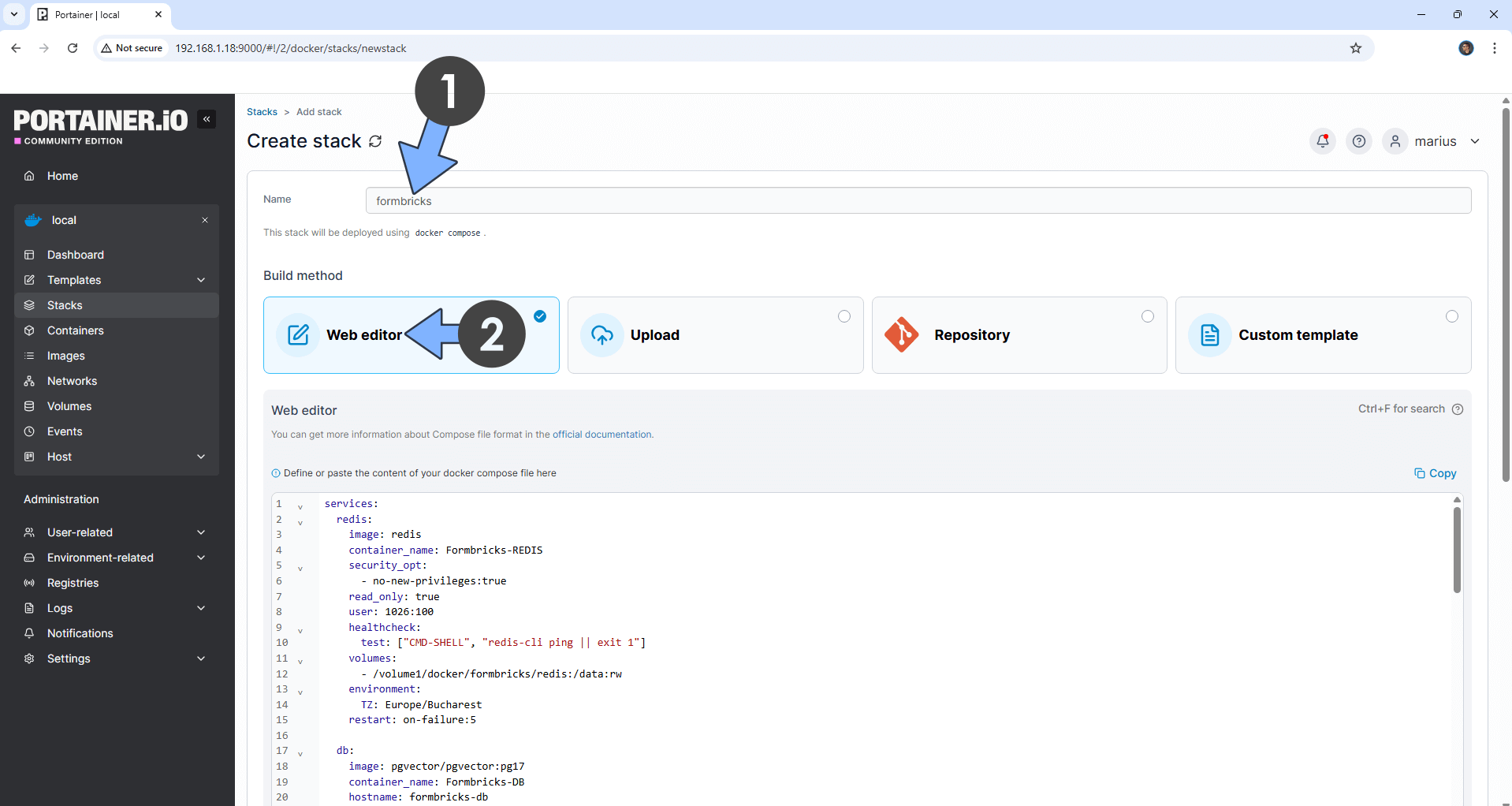
STEP 15
Scroll down on the page until you see a button called Deploy the stack. Click on it. Follow the instructions in the image below. The installation process can take up to a few minutes. It will depend on your Internet speed connection.
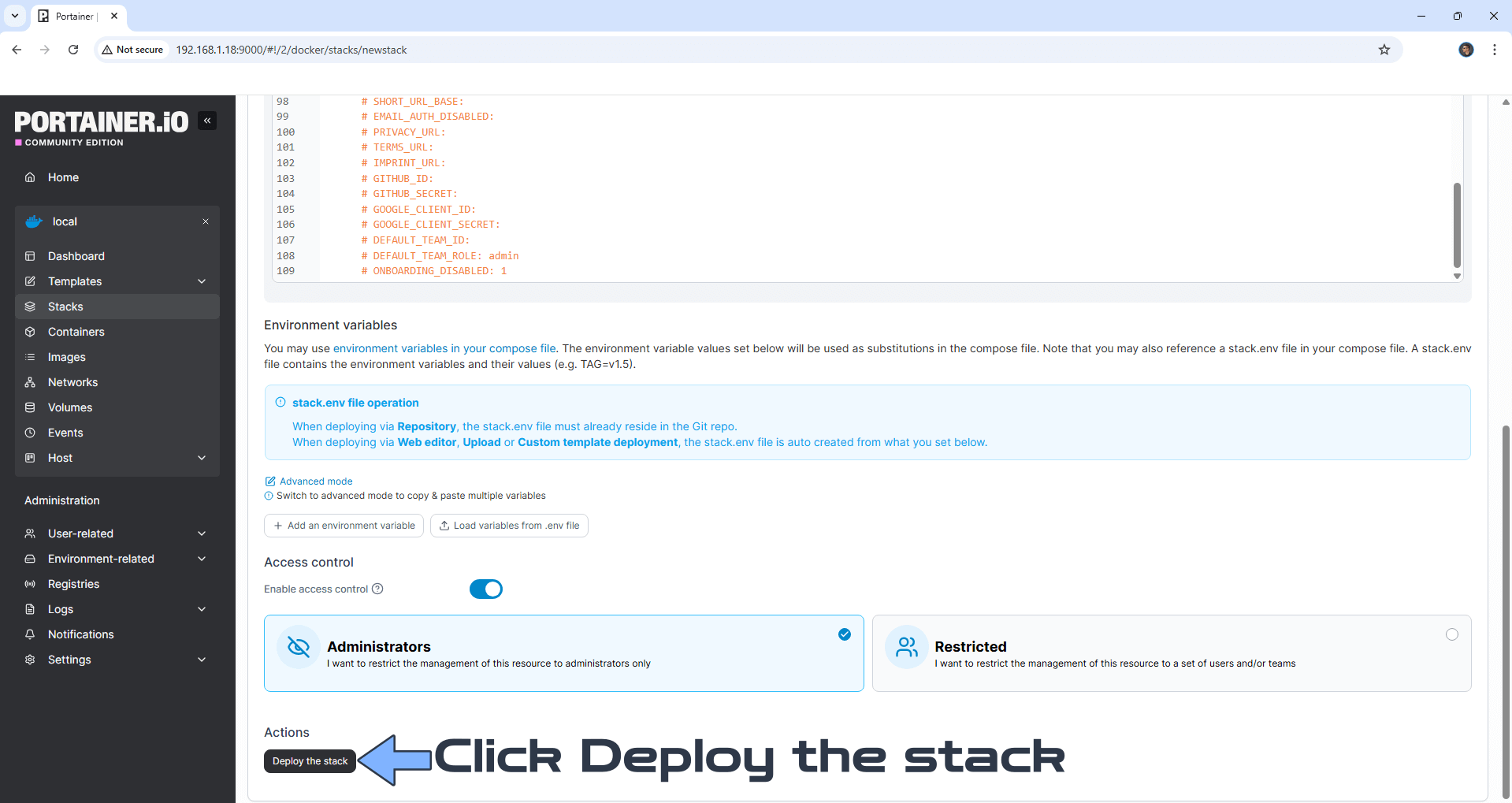
STEP 16
If everything goes right, you will see this message at the top right of your screen: “Success Stack successfully deployed“.

STEP 17
🟢Please Support My work by Making a Donation. Almost 99,9% of the people that install something using my guides forget to support my work, or just ignore STEP 1. I’ve been very honest about this aspect of my work since the beginning: I don’t run any ADS, I don’t require subscriptions, paid or otherwise, I don’t collect IPs, emails, and I don’t have any referral links from Amazon or other merchants. I also don’t have any POP-UPs or COOKIES. I have repeatedly been told over the years how much I have contributed to the community. It’s something I love doing and have been honest about my passion since the beginning. But I also Need The Community to Support me Back to be able to continue doing this work.
STEP 18
Please wait approximately 10 minutes or you will get a blank synology error page if you try to connect too soon and unhealthy container. Now open your browser and type in your HTTPS/SSL certificate like this https://formbricks.yourname.synology.me In my case it’s https://formbricks.mariushosting.synology.me If everything goes right, you will see the Formbricks Login Page. Click Get started. Follow the instructions in the image below.
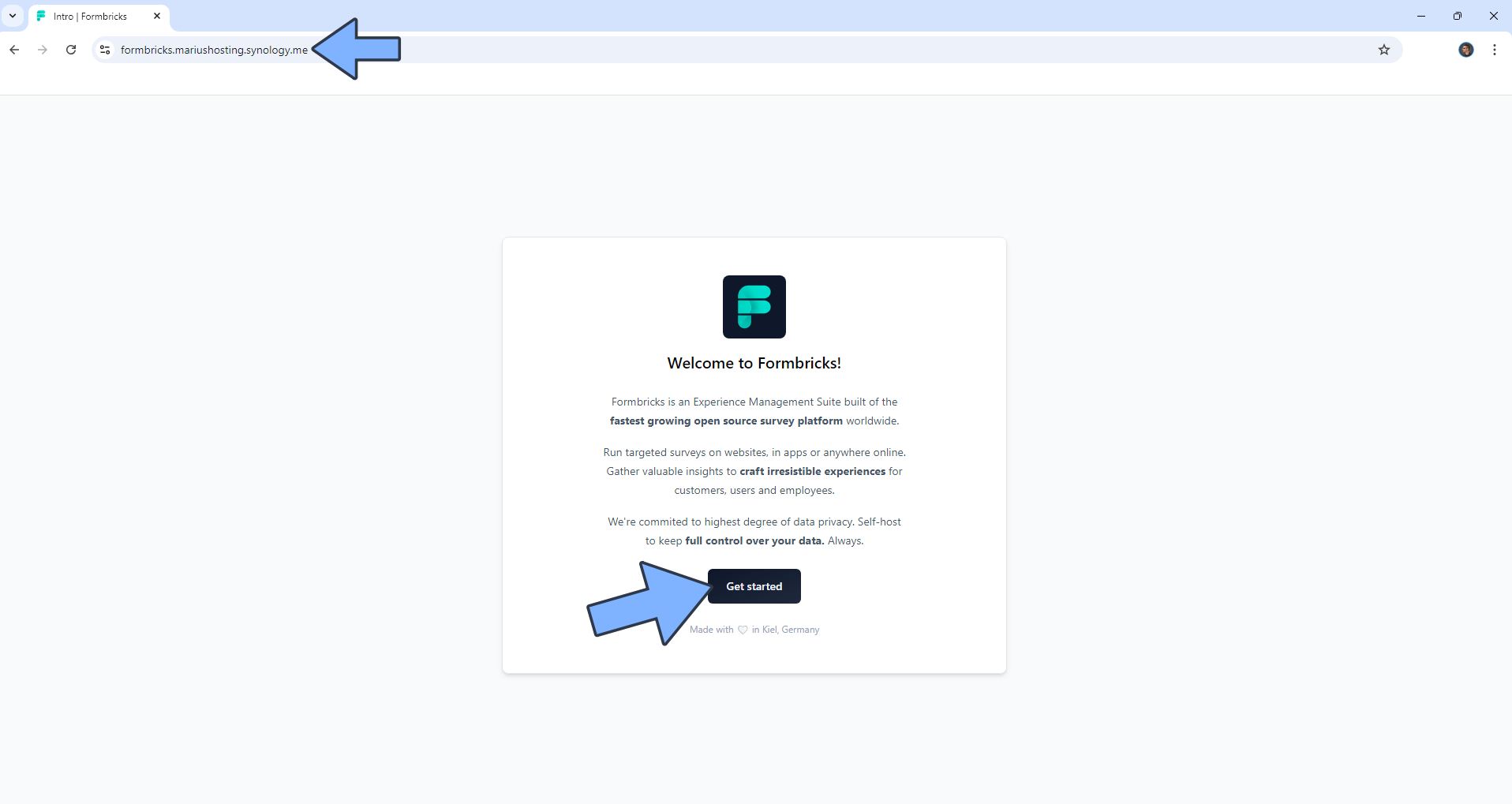
STEP 19
Click Continue with Email to Create your Administrator user. Follow the instructions in the image below.
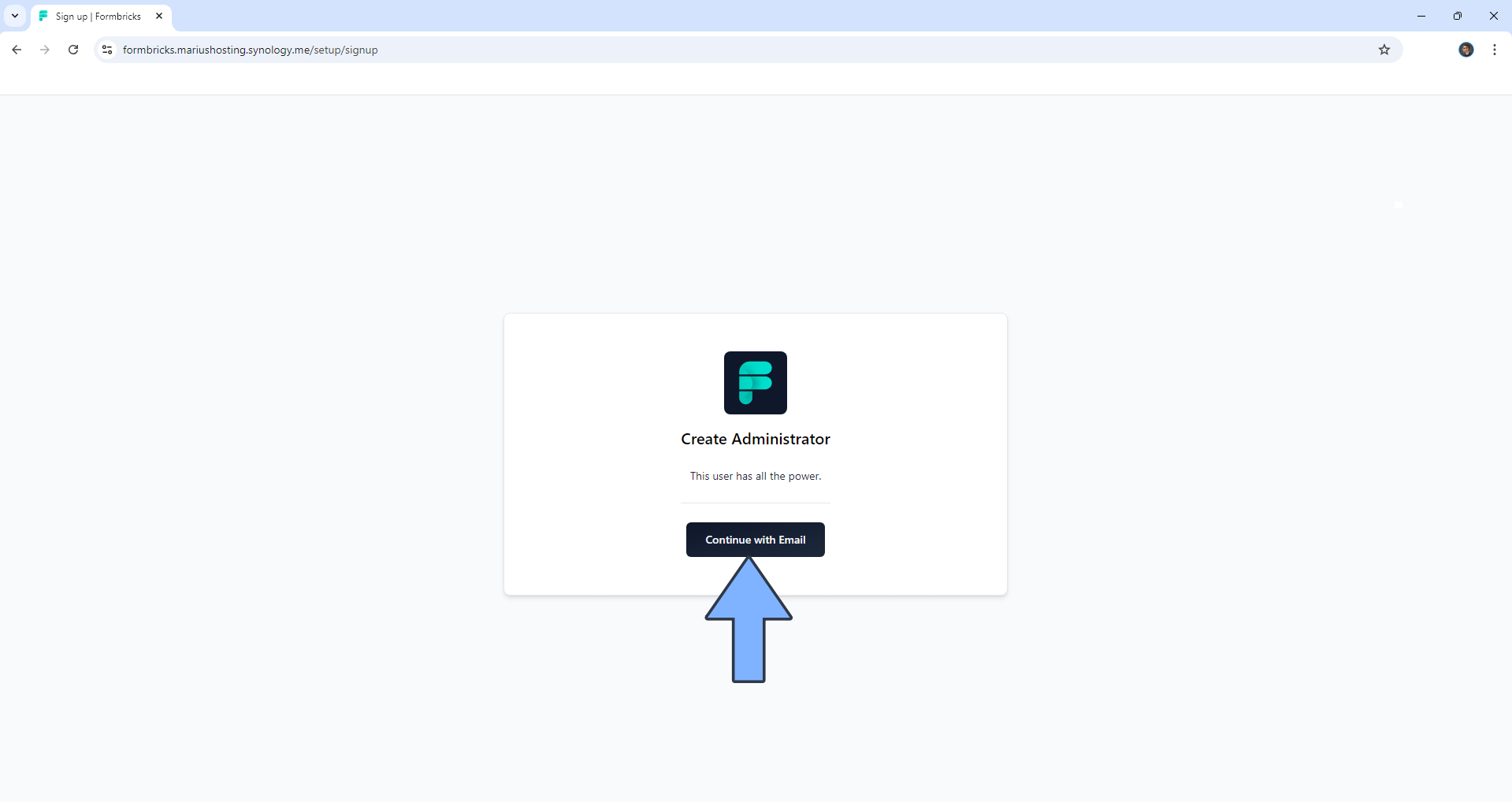
STEP 20
Type in your own details, then click Continue with Email. Follow the instructions in the image below.
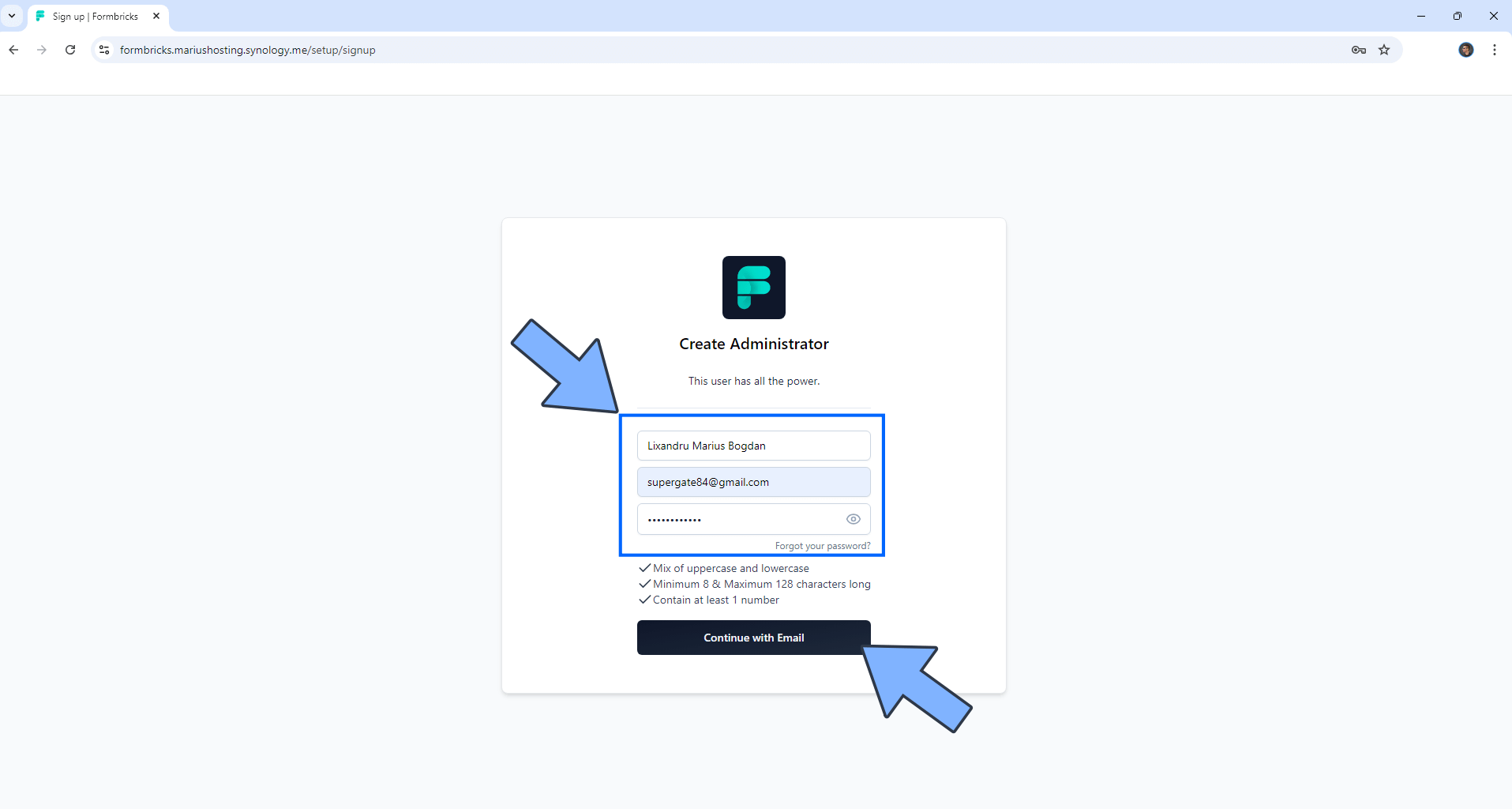
STEP 21
Click Login. If you get some red error message when creating new user, ignore it the user is already created. Click Go to dashboard. Follow the instructions in the image below.
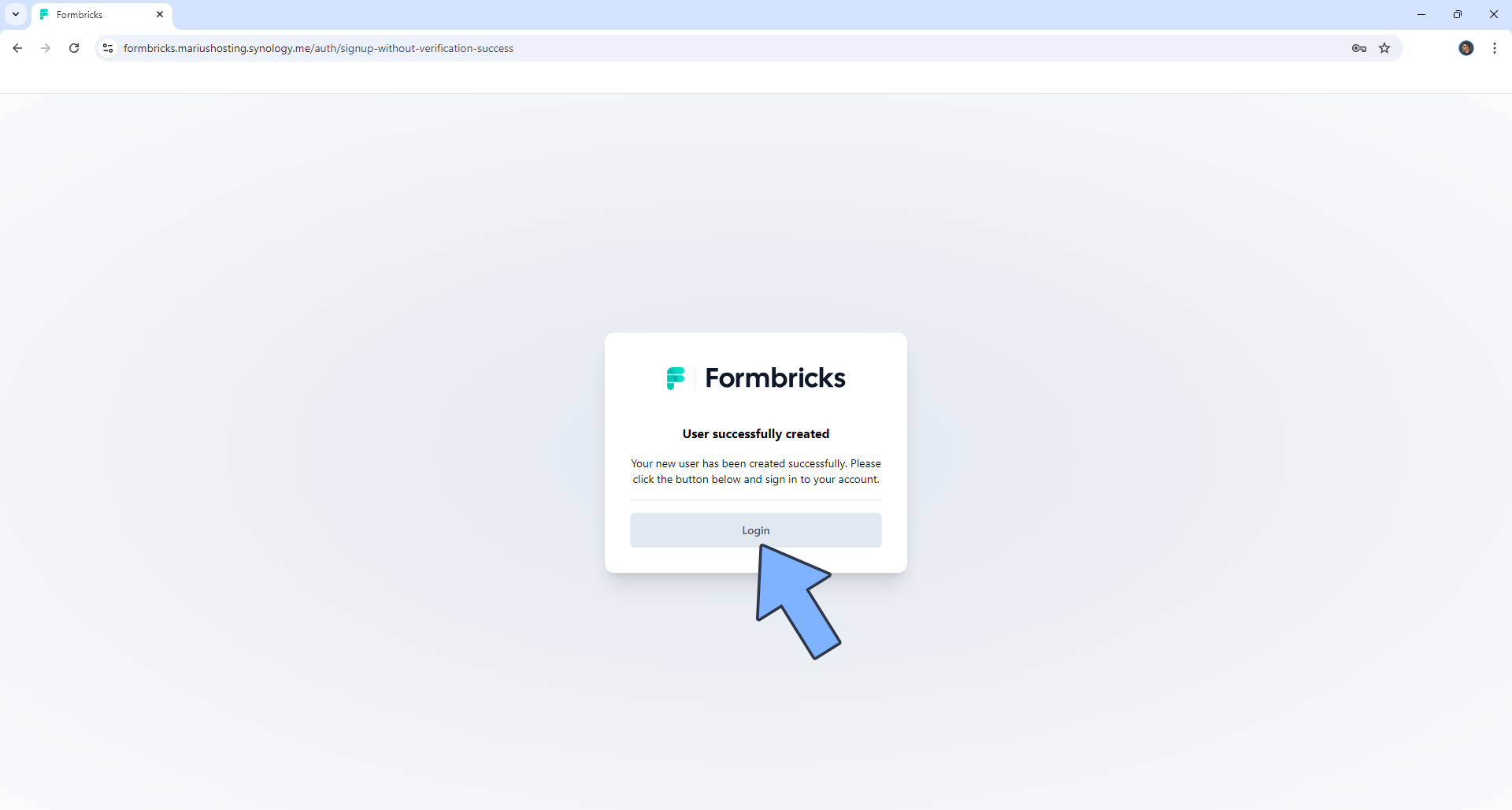
STEP 22
Click Login with Email. Follow the instructions in the image below.
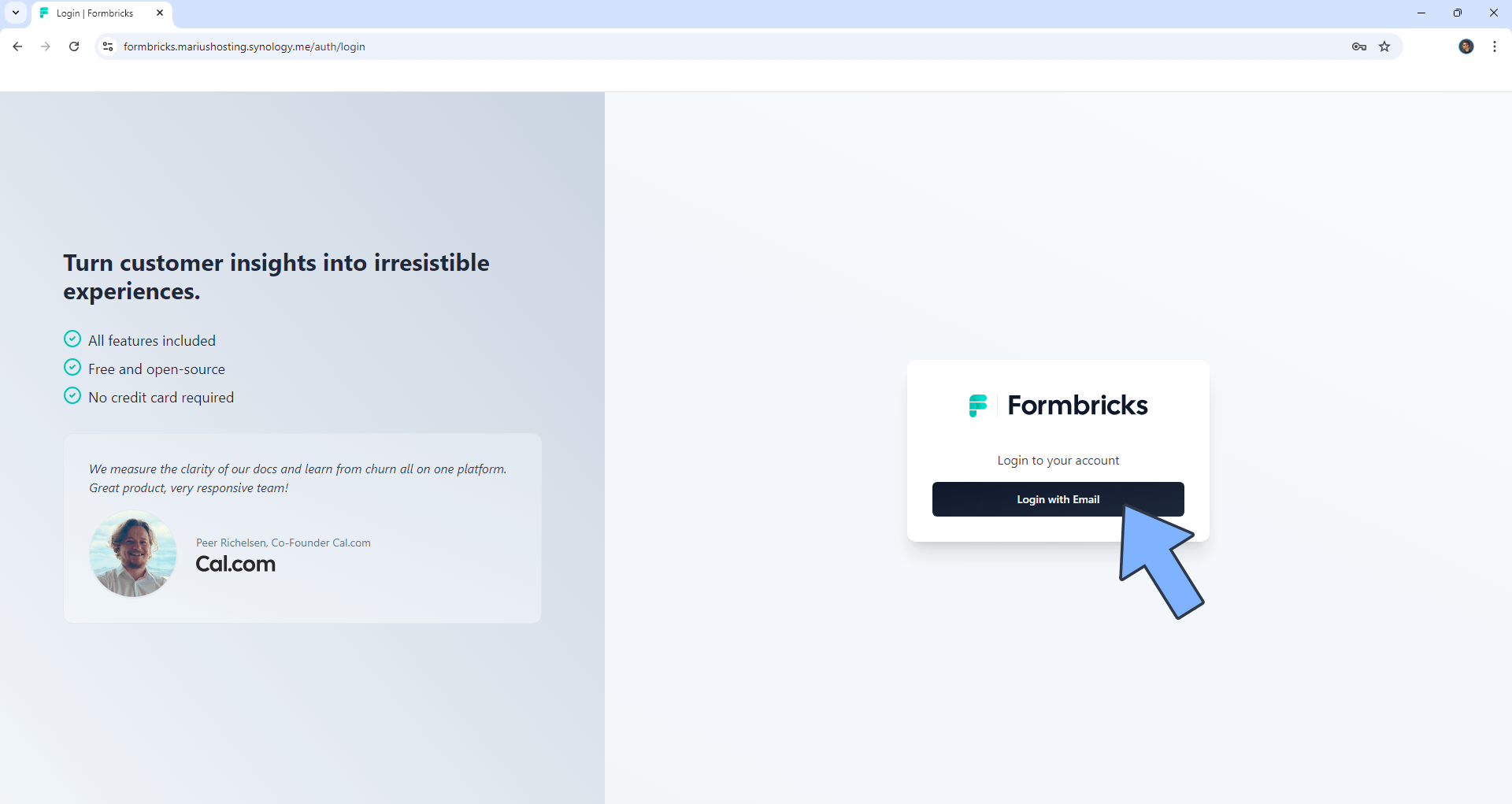
STEP 23
Type in your own Email and Password that you have previously created at STEP 20, then click Login with Email. Follow the instructions in the image below.
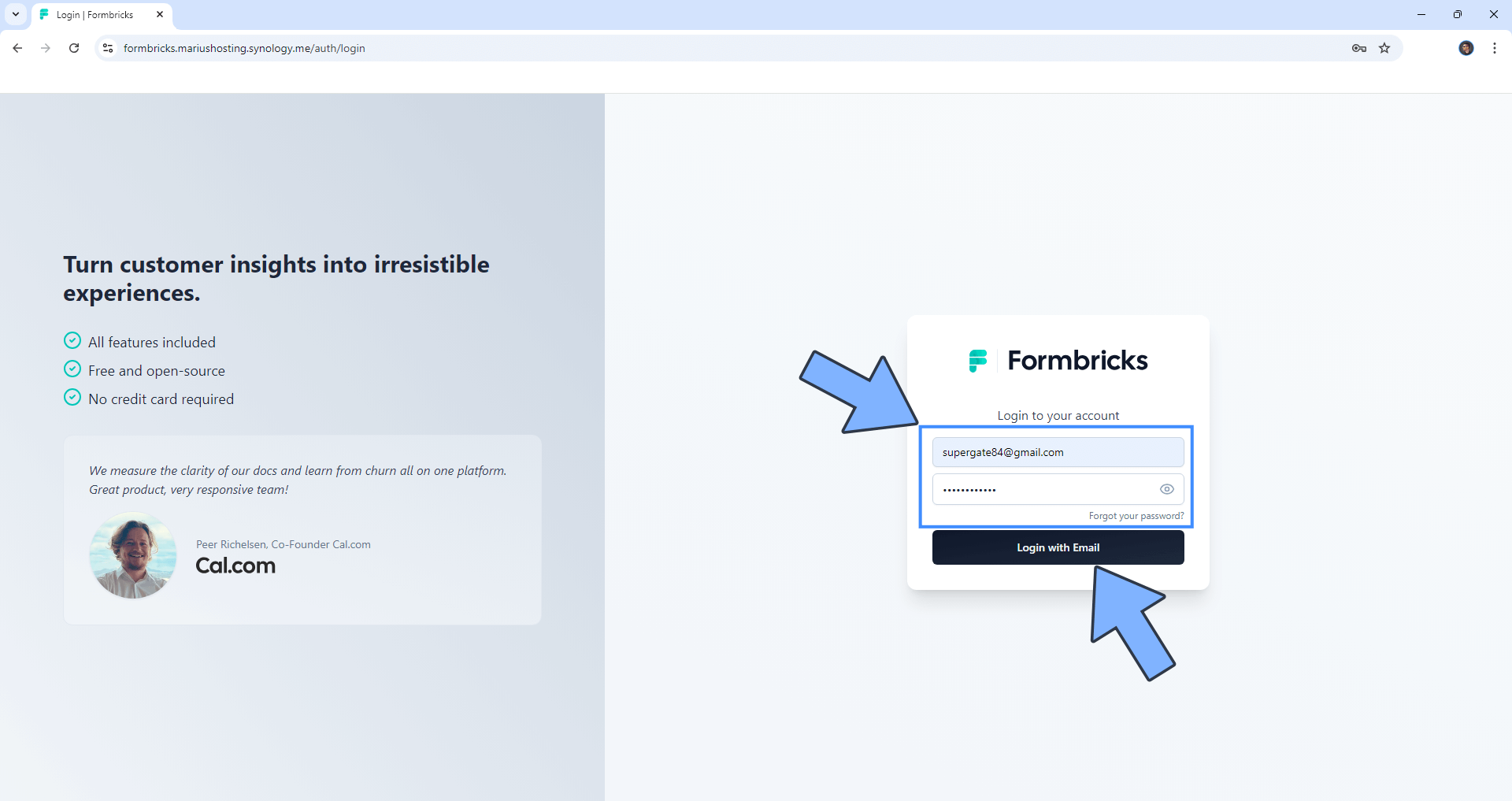
STEP 24
Type in a name for your organization, then click Continue. Follow the instructions in the image below.
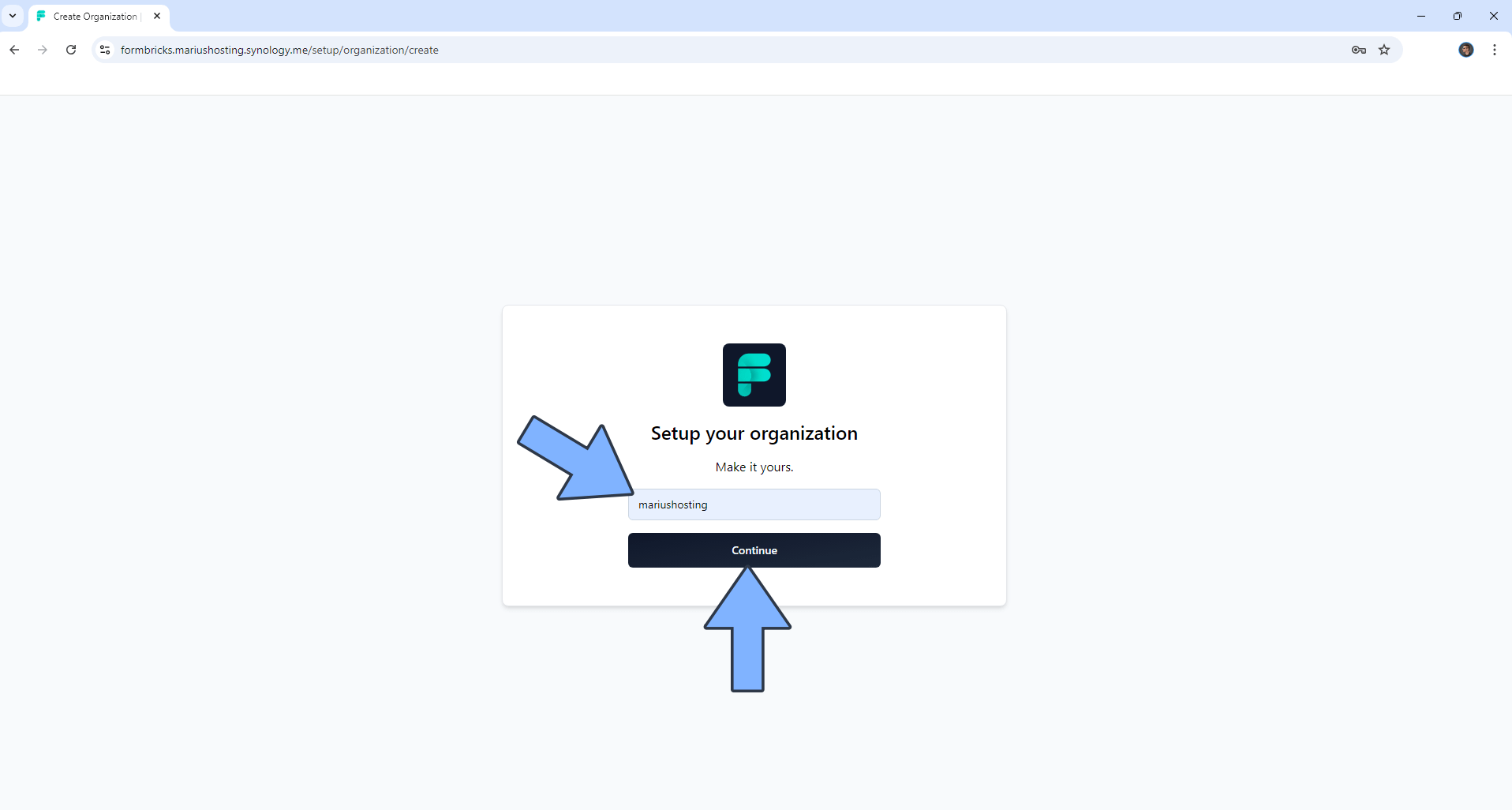
STEP 25
Invite a new member to your Organization via email, then click Continue. Follow the instructions in the image below.
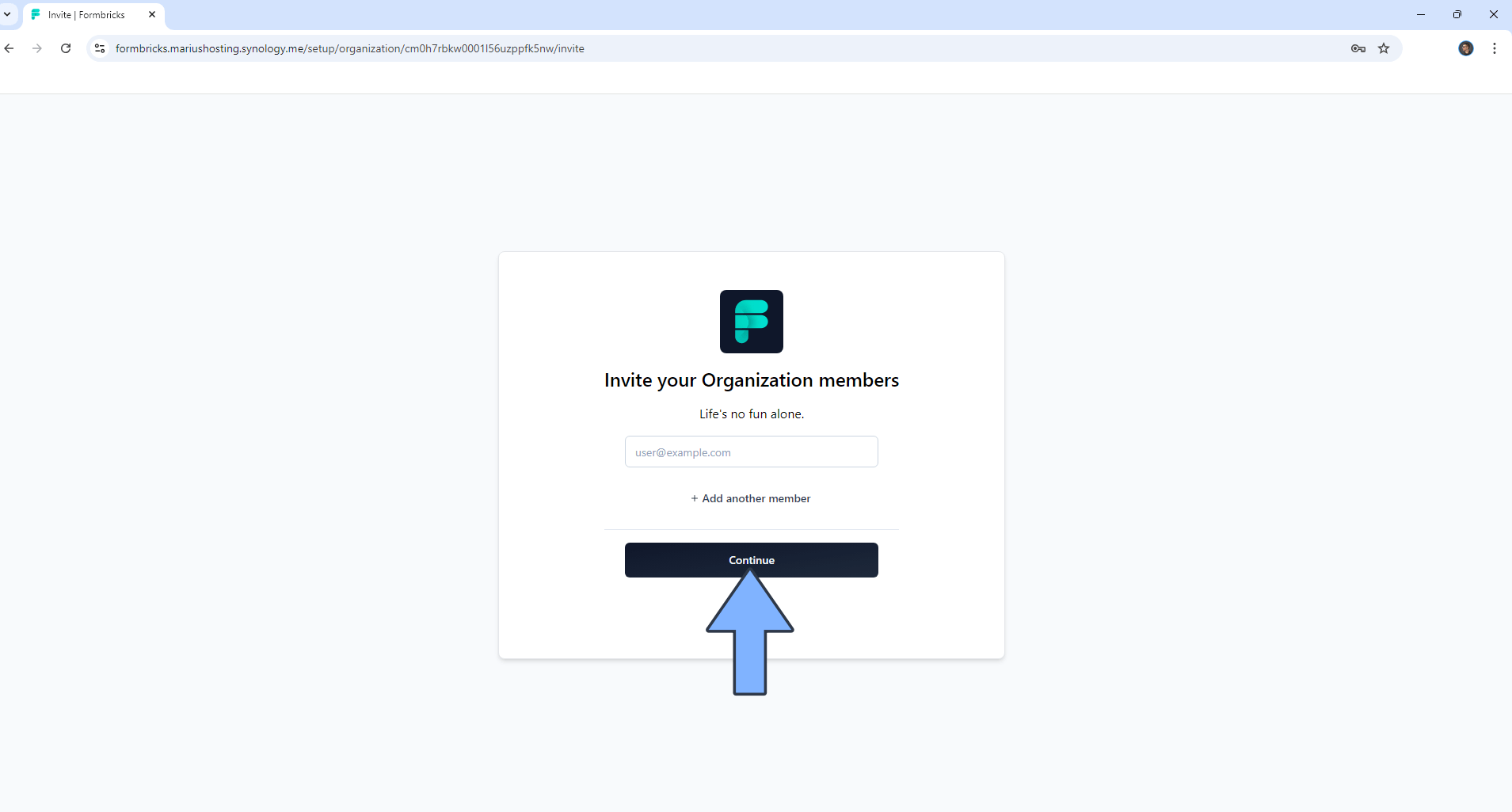
STEP 26
Select where do you want to survey people. After your selection, go straight to the next STEP.
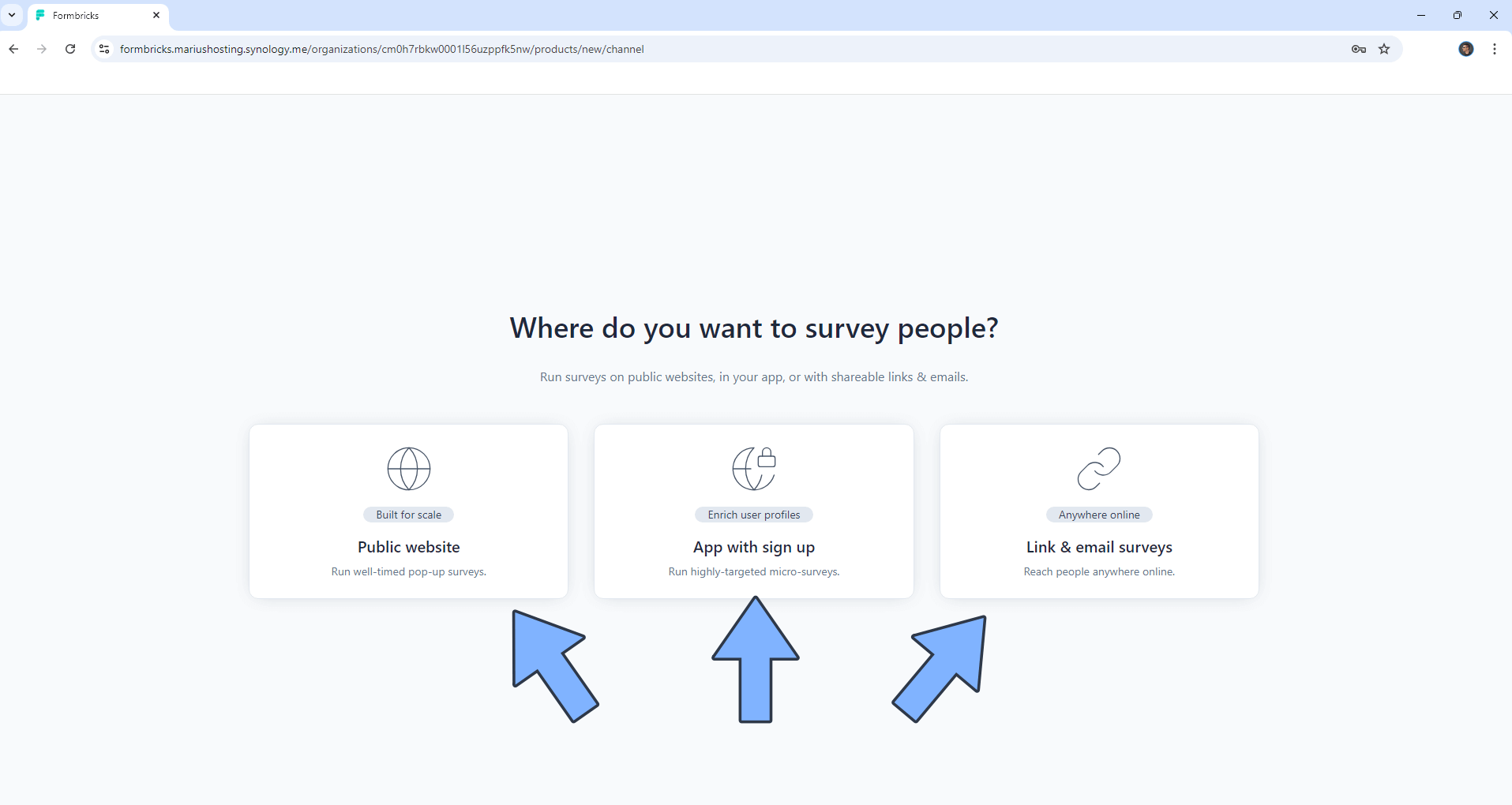
STEP 27
Select which industry do you work for. After your selection, go straight to the next STEP.
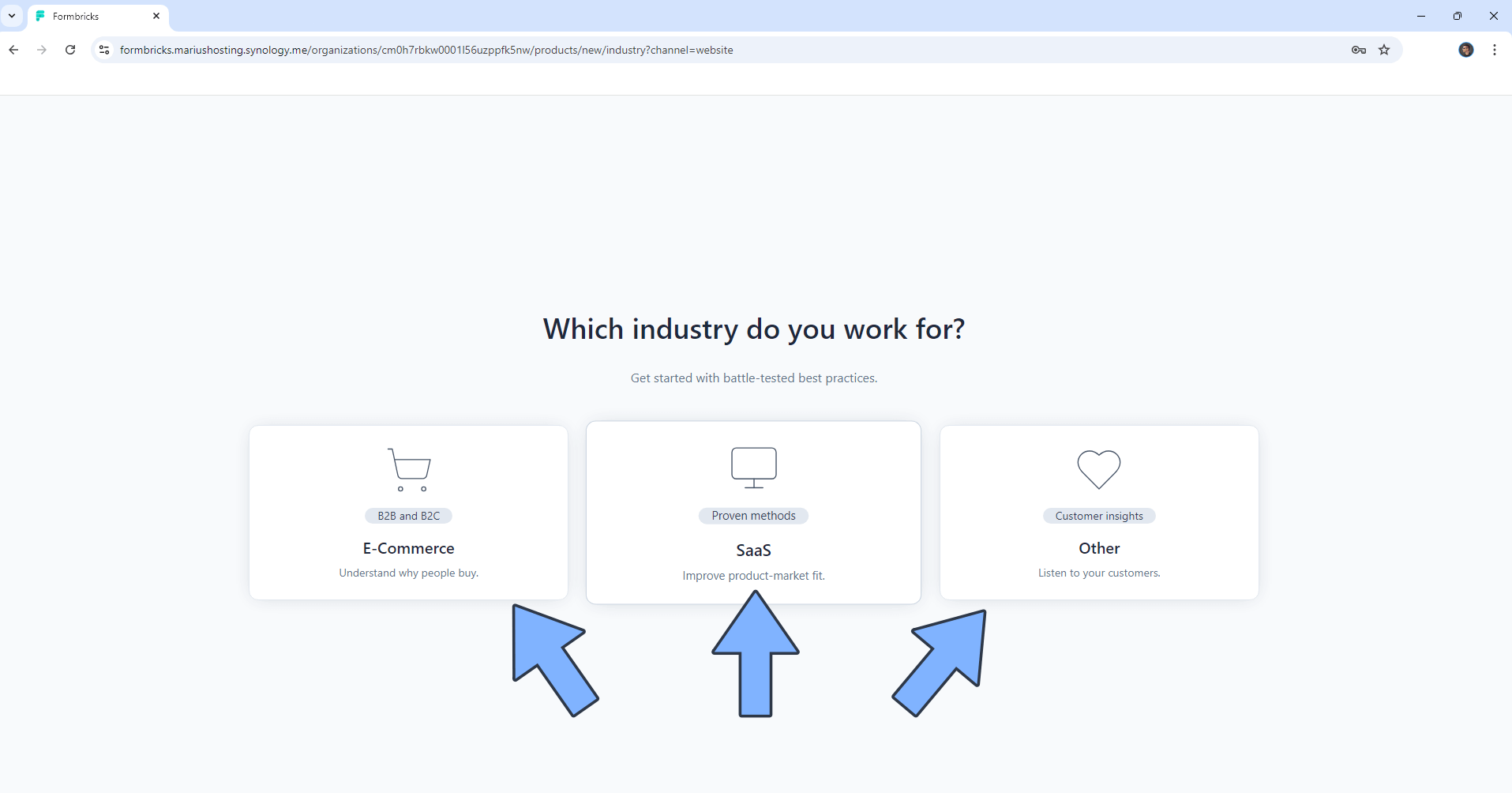
STEP 28
Give a name to your product, then select your favorite background color. Click Next. Follow the instructions in the image below.
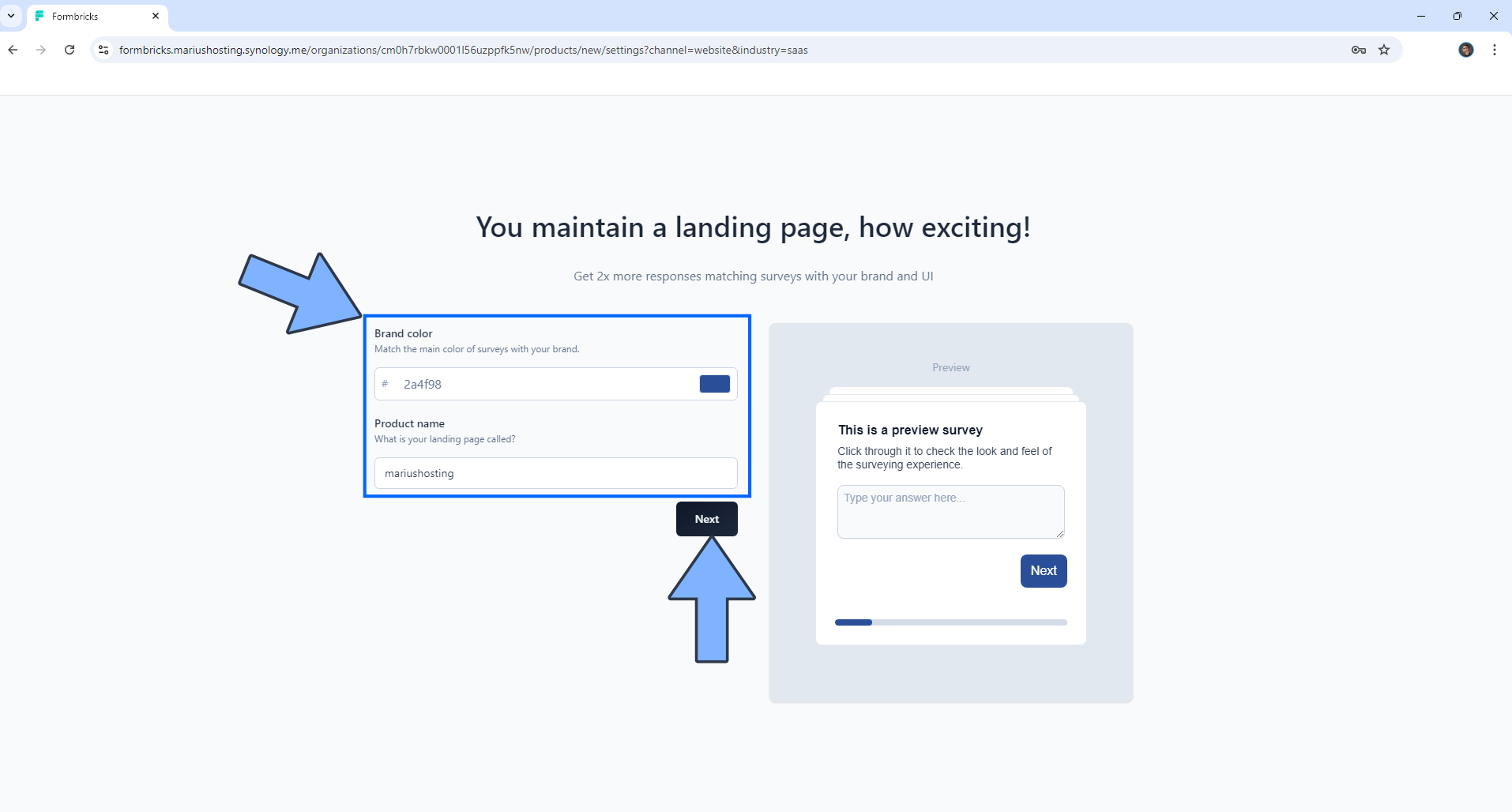
STEP 29
Copy code to add it on your website, then click “I don’t know how to do it“. Follow the instructions in the image below.
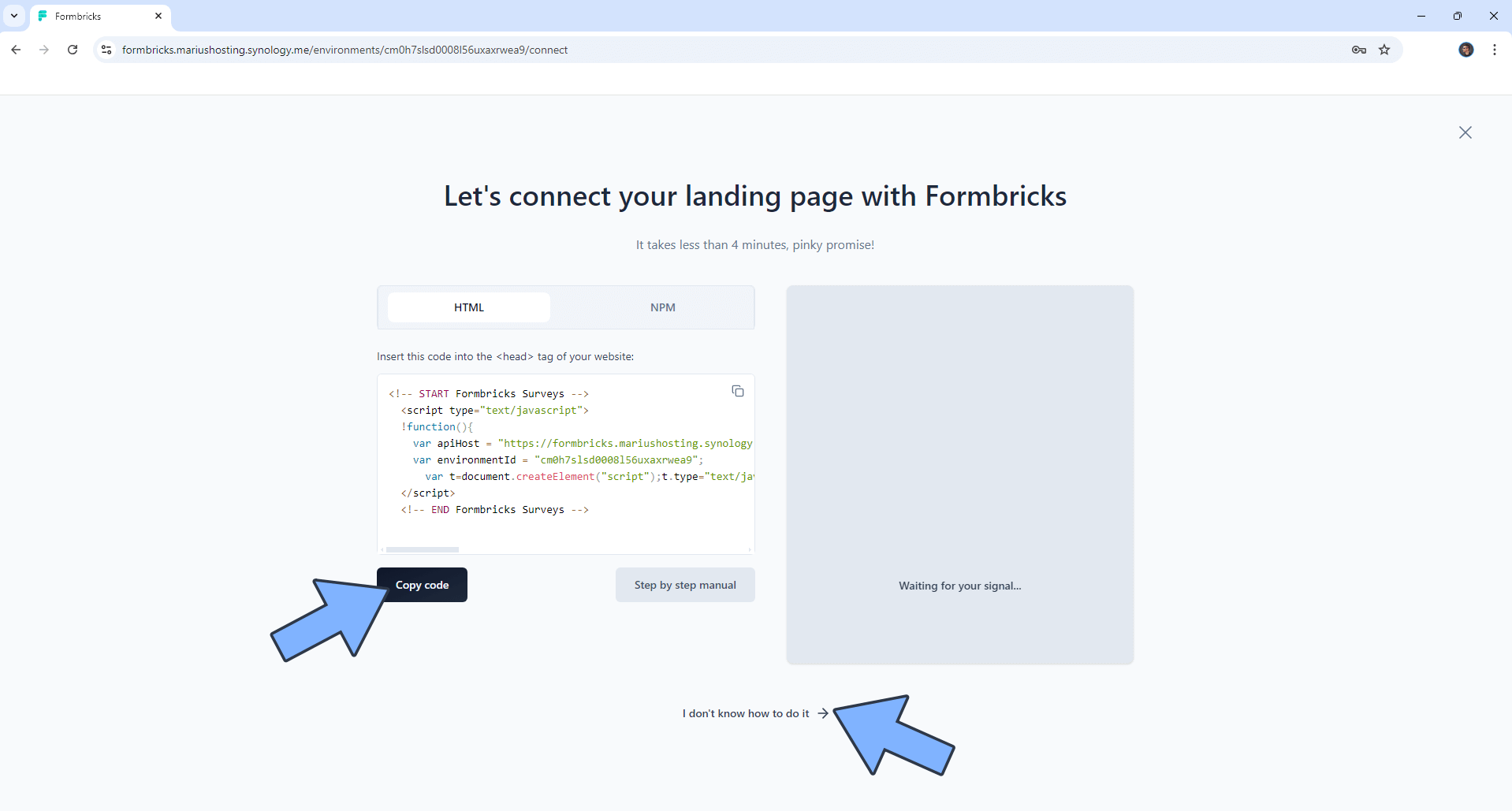
STEP 30
Click Not now. Follow the instructions in the image below.
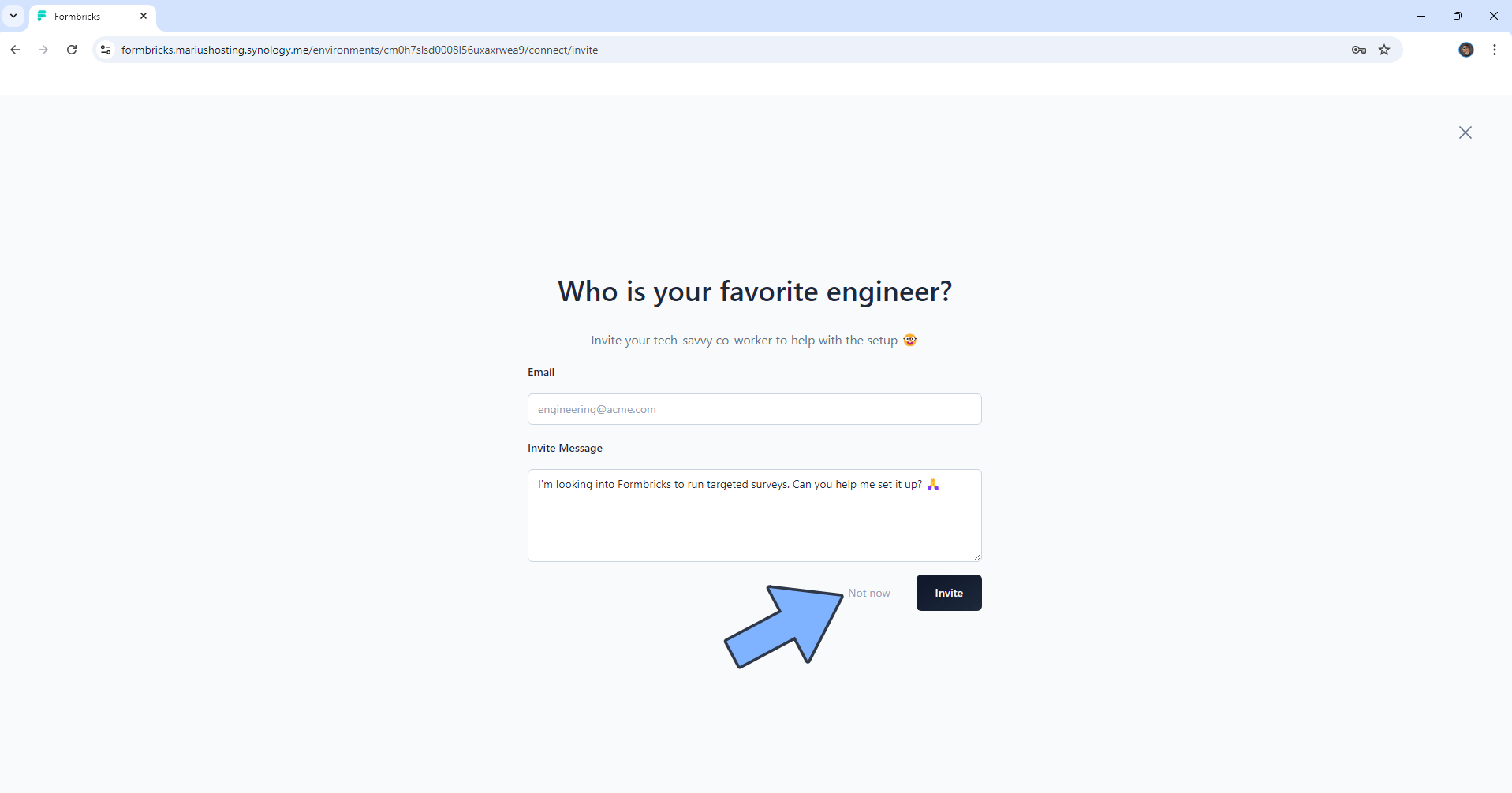
STEP 31
Your Formbricks dashboard at a glance!
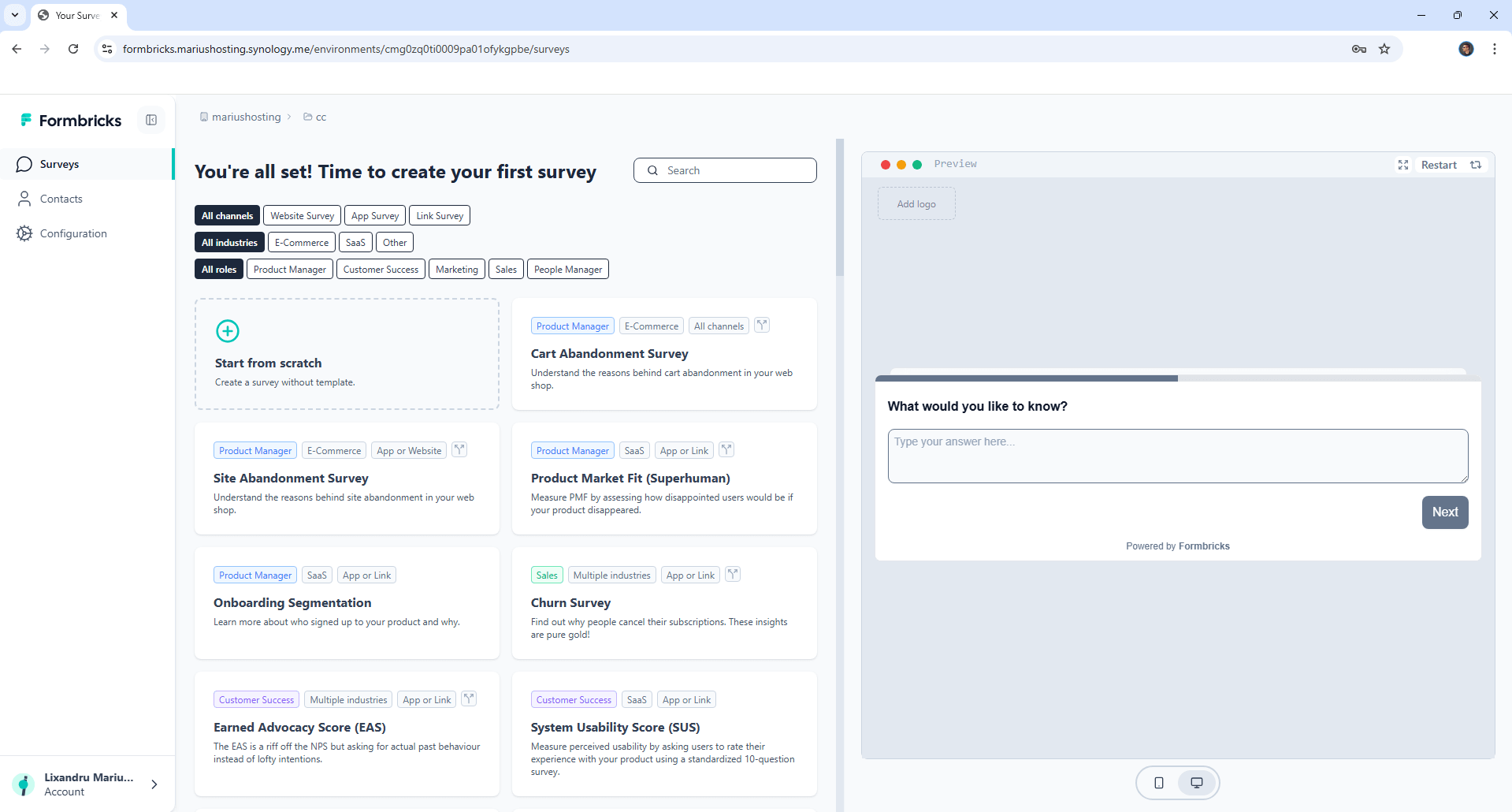
Enjoy Formbricks!
Note: Check the full Formbricks documentation!
If you encounter issues by using this container, make sure to check out the Common Docker issues article.
Fix: If your Gmail notifications don’t work, change the smtp port at STEP 14 from SMTP_PORT: 587 to SMTP_PORT: 465 then update the stack.
Note: Can I run Docker on my Synology NAS? See the supported models.
Note: How to Back Up Docker Containers on your Synology NAS.
Note: Find out how to update the Formbricks container with the latest image.
Note: How to Free Disk Space on Your NAS if You Run Docker.
Note: How to Schedule Start & Stop For Docker Containers.
Note: How to Activate Email Notifications.
Note: How to Add Access Control Profile on Your NAS.
Note: How to Change Docker Containers Restart Policy.
Note: How to Use Docker Containers With VPN.
Note: Convert Docker Run Into Docker Compose.
Note: How to Clean Docker.
Note: How to Clean Docker Automatically.
Note: Best Practices When Using Docker and DDNS.
Note: Some Docker Containers Need WebSocket.
Note: Find out the Best NAS Models For Docker.
Note: Activate Gmail SMTP For Docker Containers.
This post was updated on Friday / December 26th, 2025 at 3:22 PM
